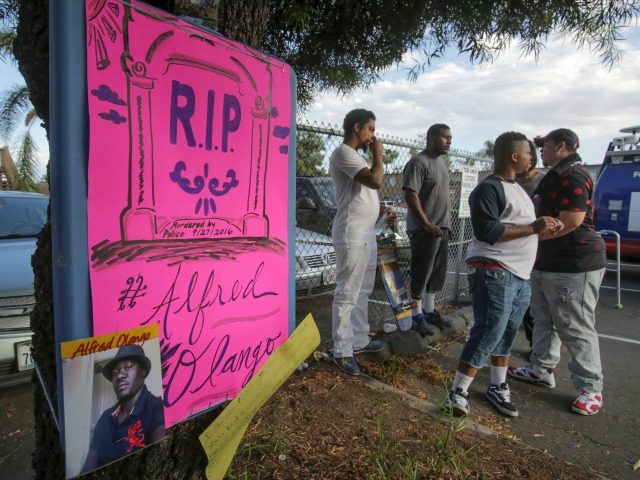The Associated Press is reporting that officials twice tried and failed to deport Alfred Olango, the former refugee with a history of mental problems who was shot and killed by police in El Cajon, California on Tuesday.
U.S. authorities tried twice to deport the unarmed black man fatally shot by police in a San Diego suburb, but his native Uganda refused to take him, resulting in his release.
Immigration and Customs Enforcement said in a statement to The Associated Press that Alfred Olango stopped reporting to officers in February 2015. Spokeswoman Virginia Kice didn’t know if officers tried to find him after that.
Olango arrived as a refugee in 1991 and was ordered deported in 2002 after being convicted on drug charges. He was released under a U.S. Supreme Court ruling barring detention of foreign nationals after six months if deportation is unlikely.
Immigration authorities took Olango into custody in 2009 after a firearms conviction in Colorado but were again unable to obtain travel documents.
Olango, 38, was shot and killed Tuesday by police in El Cajon after pulling out a large electronic cigarette, known as a vape pen, from his pocket and pointing it at the police officer who fired, while a second officer stood nearby trying to subdue him with a stun gun, according to police. A family attorney said Olango was having an emotional breakdown over the recent death of his best friend.
Each year, the federal government releases thousands of deportable aliens from jail back into Americans’ neighborhoods, because their home countries do not want the dangerous criminals returned home. For example, Thong Vang, a 37-year-old Laotian national, was allowed to stay following his release from jail in 2014 after raping three girls in 1998. He shot shot two courtroom officers in September 2016.
Olango’s death has prompted several days of protests in El Cajon.
The mental health of refugees has been a significant problem for decades, as the Utah Refugee Mental Health Subcommittee reported in 2015:
• A study conducted by The Harvard Program in Refugee Torture found that the prevalence of psychiatric disorders in the refugee communities has been revealed to be up to ten times higher than in a nontraumatized population (Fazel, M., et al., 2005)
• Studies have also documented a greater prevalence of psychiatric disorders among refugee populations when compared to the general population; these disorders include: Post-Traumatic Stress Disorder (PTSD), depression, anxiety, somatization, and adjustment reactions(Ovitt, N., et al., 2003)
• A review of Utah refugee arrivals (Wong, J., 2015) between October 1, 2009 and September 30, 2014 found that:o 27% of the total arriving refugee population had symptoms of mental health conditions
o Among those, 10% had symptoms of anxiety, 9% of depression and 25% showed symptoms of having suffered torture and violence
o The highest burden of mental health conditions and risk factors was among those between the ages of 45 and 64 years
o A higher percentage of women had mental health conditions and were twice as likely to be referred for services as men
• Structural and cultural barriers to mental health care utilization experienced by the refugees include (Wong, et al. 2006)o Cultural barriers such as distrust of Western care (greater confidence in alternative care);
o High cost;
o Language;
o Transportation; and
o Competing priorities• The refugee experience can be very traumatic and rates of PTSD and major depression in settled refugees canrange
from 10-40% and 5-15%, respectively. (RHTAC)• The rate of PTSD among all Americans is 6.8%; the rate among refugees is up to 5.8 times
higher.•The rate of major depression among all Americans is 6.7% (NIMH); refugee adults are twice as likely to experience major depression.
El Cajon is located in San Diego County, where the federal refugee resettlement program has been operated by resettlement agencies under the Wilson-Fish alternative program. More than 18,000 refugees were resettled in San Diego County in the seven years between 2009 and 2015.
As the Associate Press reported:
El Cajon, a city of 100,000 people about 15 miles northeast of San Diego, has become home for many refugees fleeing Iraq and, more recently, Syria. The population is 69 percent white and 6 percent black, according to 2010 census figures.
Because of the diversity and new arrivals, Wells said the police force is more culturally aware than others in the region.
Agnes Hassan, originally from Sudan, described Olango as an educated man with mental problems. She said she spent time in a refugee camp with Olango and that both of them suffered getting to the United States.
“If somebody has mental problem, how can you not deal with him with mental problem?” she said, wiping away tears and placing her hand on her chest. “This is not right. My heart has just broken.”
Mental health problems are not the only public health issues experienced by refugees in San Diego County. A 2013 study of 4,280 refugees who arrived in San Diego County between 2010 and 2012 by the University of California at San Diego concluded that the high rates of latent tuberculosis (TB) infection among the area’s refugees posed a risk of active TB to the entire community.
Breitbart News contacted the El Cajon, California to confirm Olango’s immigration status, but has not yet received a response.

COMMENTS
Please let us know if you're having issues with commenting.